1. Foreign direct investments in 2016
This review examines the development of foreign direct investments in 2016. The different sections of the review raise factors that affect the interpretation of the figures. The description of the statistics should also be considered when using the figures.
The statistics on foreign direct investments mainly depict financial transactions between domestic and foreign units in multinational groups and the assets and liabilities they generate, as well as international corporate acquisitions. The statistics on foreign direct investments do not, in most cases, describe foreign real investments into Finland. If, for example, a domestic company under foreign control makes a factory expansion investment in Finland and does not receive financing for this directly from a foreign investor, nothing of the value of the factory expansion investment is recorded in the statistics on direct investments. More about the definitions of the concepts used in this review can be found on the statistics home page: http://www.stat.fi/til/ssij/kas_en.html.
1.1 Global FDI
According to the investment report published by the United Nations Conference on Trade and Development, flows of global FDI decreased by around two per cent in 2016 (UNCTAD: World Investment Report 2017). The decrease in investment flows was particularly directed at investments in emerging economies. The flow of investments directed at emerging countries contracted by some 14 per cent, while the investment flows at developed countries grew by around five per cent.
Figure 1. Global flows of direct investments in 2004 to 2016
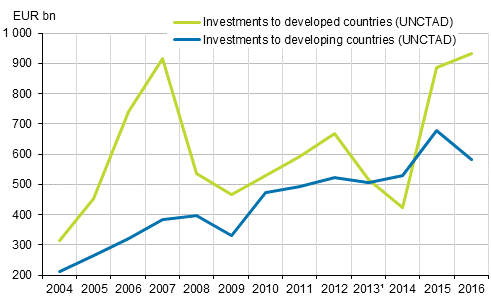
In total, global foreign direct investments amounted to EUR 1,578 billion in 2016, of which EUR 933 billion were directed at developed countries and EUR 584 billion at emerging economies. Examined by country, the USA was the largest host country of direct investments followed by Great Britain and China. The largest investor countries were the USA, China and the Netherlands. (UNCTAD 2017.)
The investment report by the United Nations Conference on Trade and Development predicts a moderate five per cent growth in global flows of direct investments in 2017. The growth in investment flows is also expected to continue in 2018. The expected growth is based, for example, on improved forecasts for economic growth, growth in international trade and positive earnings development for enterprises. On the other hand, risks for the growth in direct investments include increased political uncertainty and possible national tax reforms. (UNCTAD 2017.)
Foreign direct investments are often interpreted too simply as real investments but this is not often the case according to a study published by the Research Institute of the Finnish Economy (ETLA) in 2014 (ETLA 2014: Topias Leino and Jyrki Ali-Yrkk�: How does foreign direct investment measure real investment by foreign owned companies). Flow-through investments and enterprises' ownership changes do not often lead to real investments in the host country of the investment. On the other hand, if international enterprises operating in the country use domestic financing channels to finance their investments, this is not visible as a foreign direct investment. The heavy concentration of business activities also creates interpretation problems. Several small investments made into growth enterprises disappear into the normal intra-group financing solutions of multinational enterprises.
Figure 2. Flows of FDI in 2004 to 2016
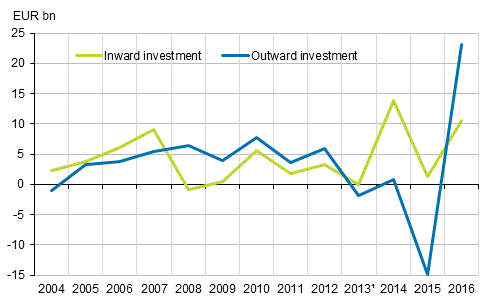
�) Starting from 2013, the figures are not fully comparable with those for 2004 to 2012 due to changes in the international statistical standard.
1.2 Finland's inward FDI
In 2016, Finland's inward FDI totalled EUR 10.5 billion on net, which is clearly more than in 2015, when the net inflow of Finland’s FDI was EUR 1.3 billion. In 2016, investments in equity-based items were EUR 9.8 billion and in debt-based items EUR 0.8 billion. The high level of investments was especially caused by corporate acquisitions. For listed companies, the value of equity capital is recognised at market value and for other enterprises at book value. In connection with corporate acquisitions, the value of equity is valued based on the market value and the actual transaction price is utilised in determining the market value.
At the end of 2016, the value of FDIs totalled EUR 76.6 billion, of which equity accounted for EUR 67.4 billion and the value of debt capital for EUR 9.2 billion. During 2016, the value of FDIs grew by EUR 1.6 billion. The investment stock of equity-based items grew by EUR 6.7 billion, which is primarily explained by positive financial transactions on net. The stock of debt-based items decreased, in turn, by EUR 5.1 billion. The drop in the stock of debt capital item investments is primarily explained by other valuation changes that include price changes and changes in classifications. A classification change refers to a situation where the counterparty of a direct investment moves, for example, as a result of an acquisition, from intra-group into non-group. This means that the investment no longer meets the criteria of a direct investment and it is classified in the balance of payments either as a portfolio investment or other investment.
Table 1. Finland's inward FDI, EUR billion
| Total | Equity | Debt | |
| Stock of investments 31 Dec 2015 | 75.0 | 60.7 | 14.3 |
| Financial transactions | 8.8 | 8.1 | 0.8 |
| Re-invested earnings | 1.7 | 1.7 | 0.0 |
| Changes in the exchange rates | -0.1 | 0.0 | -0.1 |
| Other valuation adjustments | -8.8 | -3.0 | -5.8 |
| Stock of investments 31 Dec 2016 | 76.6 | 67.4 | 9.2 |
Examined by country, direct investments have been made to Finland particularly from Sweden (46% of the investment stock), the Netherlands (16%), Luxembourg (10%) and Denmark (7%). Examined by country group, investments to Finland mainly come from the EU area, whose combined share of the investment stock was 91 per cent in 2016. The share of euro area countries was 37 per cent of the investment portfolio. The shares presented here were calculated according to the immediate investor country. In fact, investments are often managed through an affiliate abroad, in which case the ultimate controlling investor is located in some other country. These figures calculated according to the ultimate investing country are examined in more detail in Section 1.5 of this review.
Figure 3. Direct investments into Finland according to the immediate investor country on 31 December 2016.
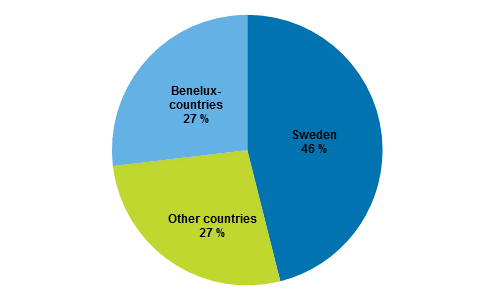
Examined by industry, inward FDI to Finland is particularly directed within services to enterprises engaged in financial and insurance activities (31% of the total investment portfolio) and other service enterprises (30%). In manufacturing, most investments have been made in metal industry enterprises (12%) and chemical industry enterprises (10%). The industry of the investment is determined based on the industry of the domestic unit. Then, the share of financing activities is increased by arrangements where a Finnish manufacturing enterprise, for example, is managed from abroad through a Finnish holding company classified in the financial sector and established for that purpose.
Finland's inward FDI generated returns of EUR 5.2 billion in total for foreign investors in 2016, of which EUR 3.1 billion were dividends and EUR 0.4 billion interests. EUR 1.7 billion of the returns were reinvested earnings that describe the difference between the returns accrued and paid to owners in a given year. The reinvested earnings of EUR 1.7 billion are also recorded in Finland’s inward FDI (see Table 1).
Returns generated by foreign investors relative to the value of the investment portfolio increased from the year before. In 2016, returns relative to the value of investments at the end of the year were 6.8 per cent, while in 2015, the rate of return was 4.9 per cent and in 2014 it was 6.3 per cent. Most returns in euros were generated by the biggest investor countries, that is, EUR 3.0 billion by Sweden, EUR 0.4 billion by the Netherlands and EUR 0.3 billion by Luxembourg.
1.3 Finland's outward FDI
In 2016, outward FDI totalled EUR 23.2 billion on net. Thus, clearly more capital flowed outward than was returned as direct investments to Finland. Foreign equity investments totalled EUR 18.0 billion on net including reinvested earnings, and debt investments amounted to EUR 5.2 billion on net. In 2016, the net amount of FDI from Finland amounted to EUR 23.2 billion, which was clearly higher than in 2015, when FDI from Finland was EUR -15.0 billion on net. The high level of FDI from Finland is mainly explained by corporate acquisitions.
At the end of 2016, the value of the stock of outward FDI was EUR 105.4 billion, of which equity accounted for EUR 112.8 billion and the value of debt capital for EUR -7.4 billion. In 2016, the stock of outward FDI grew for the first time since 2012. The considerable value increase of EUR 18.6 billion in the investment stock is primarily explained by positive financial transactions on net that were directed in particular at equity items. Other valuation changes decreased the value of foreign assets by EUR 4.6 billion. The value change of objects owned abroad, which is based on changes in the market value of listed companies and the book value of unlisted targets, are recorded in other valuation changes. Other valuation changes also include classification changes that are caused by a change in the investment type. For example, if the voting power entitling to ownership in a foreign investment object falls below ten per cent, the investment no longer fulfils the criteria of a direct investment and it is classified in the balance of payments either as a portfolio investment or other investment.
Table 2. Finland's outward FDI, EUR bn
| Total | Equity | Debt | |
| Stock of investments 31 Dec 2015 | 86.8 | 98.3 | -11.5 |
| Financial transactions | 19.2 | 14.0 | 5.2 |
| Re-invested earnings | 4.0 | 4.0 | 0.0 |
| Changes in the exchange rates | 0.0 | 0.0 | 0.0 |
| Other valuation adjustments | -4.6 | -3.5 | -1.1 |
| Stock of investments 31 Dec 2016 | 105.4 | 112.8 | -7.4 |
Examined by country, FDI from Finland is especially directed to Sweden (27% of the investment stock), the Netherlands (17%), France (13%) and the USA (6%). Examined by country group, investments are mainly directed to the EU area, whose combined share of the investment portfolio was 83 per cent at the end of 2016. The share of the countries belonging to the euro area in the stock of outward FDI was 51 per cent.
The shares above were calculated according to the country of the immediate investment target, in which case, for example, the appeal of the Asian rising economies is small. For example, the value of the stock of investments to China was EUR 1.1 billion at the end of 2016, i.e. one per cent of the value of outward FDI. However, according to Statistics Finland’s statistics on Finnish affiliates abroad, the main investment target of Finnish affiliates in 2015 was China, where a total of 228 Finnish affiliates were operating in 2015 and their share of the turnover generated abroad was 7.4 per cent. There are no data available on outward FDI according to the country of the ultimate investment target, so it is not possible to give a more exact specification of the final investment target. However, most of the investments to the Benelux countries are connected to the management of a global enterprise or its part and the actual production activity is located in some other country.
Figure 4. Finland's outward FDI by immediate investor country on 31 December 2016.
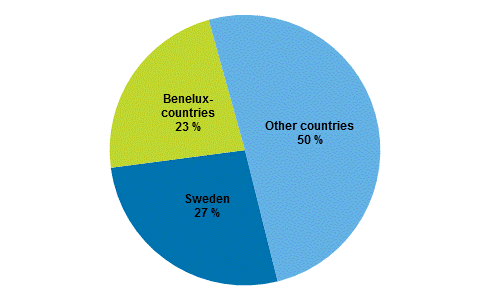
The industry of foreign direct investments from Finland is determined based on the industry of the Finnish investor. Examined by industry, Finland’s outward FDI is dominated by manufacturing industries, especially by metal industry (33% of the total investment portfolio) and forest industry (11%) enterprises. Among service industries, most investments were held by enterprises engaged in financial and insurance activities (21%) and other services (12%). The value of financial and insurance activity enterprises' foreign investments grew by EUR 16.7 billion in 2016 and, correspondingly, the value of other service enterprises’ investments decreased by EUR 15.9 billion. The changes in the value of these investments were mainly caused by classification changes between these two industry categories.
Outward FDI generated returns of EUR 8.9 billion in total for Finland in 2016, which is EUR 2.2 billion more than in 2015. Of the 2016 returns, EUR 4.5 billion were dividends, EUR 0.4 billion interests and EUR 4.0 billion reinvested earnings. The reinvested earnings are also recorded in Finland’s inward FDI (see Table 2).
Returns gained by Finland relative to the value of FDI of the previous year. In 2016, the rate of return was 8.4 per cent, having been 7.7 per cent in 2015. Finland gained most returns in euros from the Netherlands (EUR 4.5 billion) and Sweden (EUR 2.8 billion).
1.4 Direct investments in the balance of payments
At the end of 2016, the value of Finland's inward FDI stock was EUR 76.6 billion and that of outward FDI stock was EUR 105.4 billion. The values of both inward and outward FDI grew during 2016. The value of outward FDI grew considerably more than the value of inward FDI and thus the net investment position of direct investments strengthened as the international direct investment assets on net increased to EUR 28.8 billion from EUR 11.9 billion in 2015. Direct investments improve, in particular, the net international investment position of the non-financial corporations sector, which stood at EUR 30.0 billion at the end of 2016. The liabilities of financial and insurance corporations related to direct investments exceeded, in turn, the assets by EUR 4.4 billion. The net international position connected to direct investments is the same in the statistics on balance of payments and international investment position, although the gross figures of balance of payments differ from the figures presented here according to the directional principle (The differing statistical method of balance of payments is discussed more in Section 2.2 of the review for the statistical reference year 2013).
Figure 5. Foreign direct investments in 2004 to 2016.
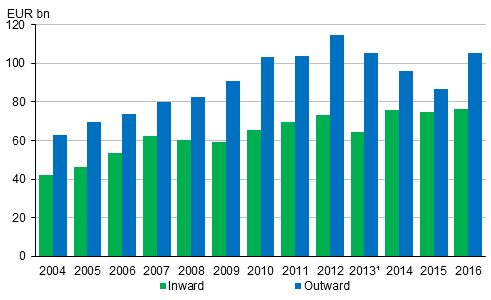
�) Starting from 2013, the figures are not fully comparable with those for 2004 to 2012 due to changes in the international statistical standard.
In 2016, returns on inward FDI amounted in total to EUR 8.9 billion and on outward FDI to EUR 5.2 billion. This property income is recorded in the primary income item of Finland's current account and its net effect on Finland's current account was EUR +3.6 billion in 2016. Figure 6 shows that returns connected to direct investments have improved Finland's current account throughout the reference period 2004 to 2016. Annual returns gained by Finland from direct investments have varied between EUR 5.2 and 8.9 billion and the investments have yearly produced a surplus of EUR 1.2 to 4.3 billion.
Figure 6. Returns on FDI in 2004 to 2016.
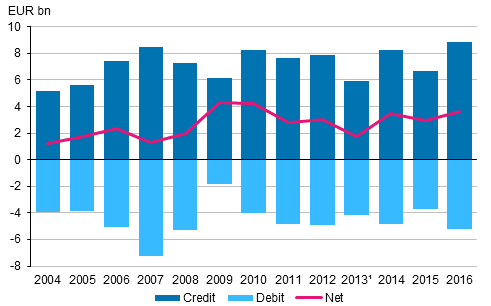
�) Starting from 2013, the figures are not fully comparable with those for 2004 to 2012 due to changes in the international statistical standard.
1.5 Investments according to the ultimate investing country
Direct investments have conventionally been examined only on the basis of the immediate investor country. The new statistical standards and data collected on a more detailed level than before also enable country-specific analyses of direct investments by the ultimate investing country starting from 2013. The ultimate direct investor here refers to the one that is topmost in the ownership chain of the foreign direct investor. The ultimate direct investor is not controlled by any other unit and it can also be a domestic unit.
Figure 7 shows that direct investments to Finland have been made clearly more from Sweden, the Netherlands and Luxembourg if investments are viewed according to the immediate investor country than when the investments are examined according to the ultimate investing country. This indicates that these investments are managed through an enterprise located in these countries, although the actual investor is elsewhere. The case is opposite for China and the United States. This means that a clearly larger share of FDI into Finland is managed in these countries than made immediately into Finland. Examined by the ultimate direct investor, the share of Finland is also significant. This is because domestic enterprises own domestic affiliates through their foreign affiliates.
Figure 7. FDI to Finland in 2016, investment portfolio
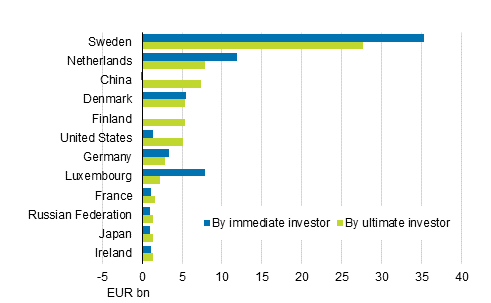
1.6 Finland's outward FDI by ultimate investing country
It is not possible to compile statistics on Finland's outward FDI by ultimate investing country with the help of the available data sources. However, by examining the ownership chains of enterprises that have made foreign investments from Finland we can examine what proportion of Finland's outward FDI has been made by enterprises that are under Finnish control. The limitation of such an examination is also that it covers only the ownership chain of units in corporate form. For example, the actual owners of a parent company registered in Luxembourg can be Finnish private citizens.
In 2016, the value of Finland's outward FDI was EUR 105.4 billion, of which 86 per cent were held by enterprises under Finnish control. The most significant ultimate investing countries outside Finland were Sweden, the United States and the Benelux countries (see Figure 8).
Figure 8. Finland's outward FDI by ultimate investing country in 2016.
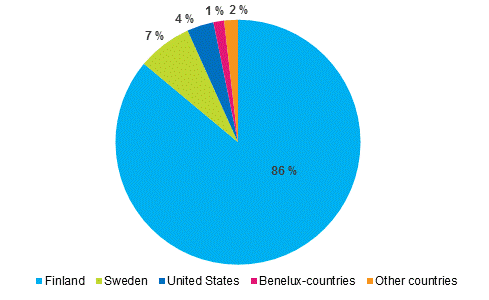
Source: Foreign direct investments 2016, Statistics Finland
Inquiries: Kristian Taskinen 029 551 2238, Johannes Nyk�nen 029 551 3641, balanceofpayments@stat.fi
Director in charge: Ville Vertanen
Updated 30.11.2017
Official Statistics of Finland (OSF):
Foreign direct investments [e-publication].
ISSN=2342-351X. 2016,
1. Foreign direct investments in 2016
. Helsinki: Statistics Finland [referred: 21.12.2025].
Access method: http://stat.fi/til/ssij/2016/ssij_2016_2017-11-30_kat_001_en.html

